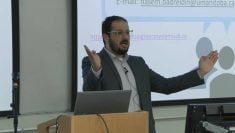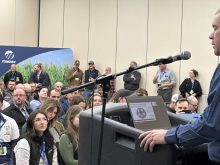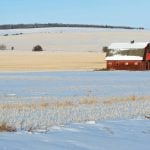You could say it’s an old idea that’s new again.
The idea is taking topsoil from where it has accumulated in low areas and putting it on badly eroded knolls or hilltops to increase the productivity of a field. University of Manitoba soil scientist David Lobb maintains that’s something farmers in hilly regions of China and Europe have been doing for centuries, but it’s been virtually ignored as a useful — and sustainable — farming practice by ag researchers around the world.
That may be starting to change. Lobb has been studying the practice of soil landscape restoration, as it’s known, for more than a dozen years. Newer to the game are Jeff Schoenau and Curtis Cavers, two Prairie soil specialists influenced by Lobb’s work who are currently assessing the agronomic and economic benefits of farmland soil restoration through research trials.
Read Also

Claas brings 1000 Series SP forage harvesters to Canada
In mid-August, Claas unveiled its new line of Jaguar forage harvesters at an event in Visalia, California, deep in the heart of that state’s dairy region.
That’s not to say some western Canadian farmers — like Manitoba’s Dallas Timmerman — haven’t already figured out the value of moving topsoil around.
Timmerman, who grows canola, wheat, barley, peas and forage alfalfa on his farm near Treherne, Man., has been doing it for years. The first time was back in the 1990s when he had an aha moment while running a Leon land scraper to clean out some old water runs on the family farm.
“As I was scraping, I figured, well, instead of just dropping (the dirt) here in another low spot, I went up and started putting it on ridges and small hills, just knowing that that was good soil,” Timmerman says.
He continued and expanded the practice to other fields after seeing positive change — the straw grew taller and the heads filled out better — with crops growing on the hills.
Timmerman says he uses older equipment that doesn’t have yield monitors, but if he had to hazard a guess, he’d say yields in the improved areas went up “anywhere from two to seven bushels an acre.”

Every two or three years, Timmerman would spend a week or so after harvest redistributing topsoil, scraping off six to eight inches of it from low areas and placing it on eroded hilltops. He’s been too busy to do this in recent years, but he plans to get back at it. “I definitely see a benefit in it,” he says.
Lobb says Timmerman certainly isn’t the only Canadian farmer who’s seen the sense of moving topsoil around. “Once we looked into it, we found out there was a bunch of farmers who have been doing it for decades, not a large number, but some.”
Weighing the costs
Hauling topsoil around a field isn’t a simple operation — it requires time, labour, the right equipment and fuel to run it. Is the return on investment worth it for farmers?
Lobb, along with U of M researchers Gary Johnson and Anais Hacault, examined that question in a study for the Manitoba government in 2009. Their financial assessment of the practice concluded “landscape restoration is economically feasible (payback within four to six years) and should be considered as a worthwhile land improvement practice, similar to drainage and irrigation, and should be promoted as such.”
An agronomist with Agriculture and Agri-Food Canada, Cavers is evaluating the production value of landscape soil restoration as part of his studies at the U of M (Lobb is supervising his PhD work).
“I always look at things we can do to help producers make effective and meaningful change on the landscape. Knowing that takes time. We’ve got to balance the pros with the cons of moving topsoil and make sure we do things in a very methodical science-based way,” Cavers says.
“There’s been economic work done on this previously in other studies. And the payback, it ranges from four to six years and others say possibly longer,” he adds. “(We’re) trying to get a better handle on what are the long-term benefits and drawbacks of doing this, and if we can show that the benefits are longer lasting and outweigh the negative impacts, then that’s a plus for doing this kind of work.”
In 2020, Cavers started collecting the first year of data from three research sites in south-central Manitoba, all of them located on farms with natural rolling topography.
“We’re looking at a few severely eroded landscapes where the hilltops have very little to no topsoil left there,” he says. “For the most part, we believe that’s from long-term tillage erosion losses, and we are trying to see if taking topsoil that’s moved downhill into the lower lying areas and putting it back up on these eroded hilltops helps to quickly restore crop productivity.
“In the short term, we know removing topsoil from a lower lying area is going to cause some negative impacts there. But the theory, based on previous research and what we’re doing here, is that the addition of topsoil on severely eroded areas is going to have a longer lasting positive impact than removing topsoil from these low-lying areas,” says Cavers.
“By adding topsoil, you’re essentially adding high-quality organic matter. Topsoil is organic-rich soil material, so we’re transferring that organic matter to areas of the field where it is needed most. You’re adding material that’s going to retain moisture on those eroded hilltops which are lacking moisture, so we’re hoping that the increased moisture-holding capacity is a major benefit.”

The nutrients in organic matter should make the eroded hilltops more fertile, Cavers notes. It’s also hoped the added biological and physical benefits of topsoil will result in better seedbeds, he says, “creating something that’s a little more conducive for seeds to germinate in as opposed to the exposed shaley or gravelly subsoil that we were dealing with initially.”
It’s too early in the research project to discuss findings, although the yield differences between the treated sites and control sites were somewhat less than expected this year, says Cavers. That’s because the growing season was just so dry.
“We hardly got any moisture in 2021, so even though we’ve got more moisture-holding capacity with this added topsoil (on the hilltops), there was no significant moisture to store,” he says.
Saskatchewan study
It’s not the focus, but soil landscape restoration is an important aspect of research being performed by Schoenau, a soil fertility professor at the University of Saskatchewan and also the Saskatchewan Ministry of Agriculture soil nutrient management chair in the College of Agriculture and Bioresources.
Schoenau and his U of S colleague Ryan Hangs started a three-year study in 2020 called the Rebuilding Productivity in Eroded Knolls project. They are looking at how adding different soil amendments (phosphorus, zinc and copper fertilizers and solid cattle manure) as well as topsoil replacement affects the fertility of wheat, canola and pea crops on eroded knolls. The research is taking place on a farm where there has been significant tillage erosion dating from 1920 to the 1990s, when zero till was introduced.

The knolls being studied are “really eroded badly. They are white with exposed C horizon, and there’s very little organic matter. There’s poor soil structure. Those are the ones you’d want to go after first in terms of addressing this,” says Schoenau.
The topsoil replacement treatment, which involved depositing about 10 centimetres of soil scooped out from slough areas on the farm, was actually added at a late stage, a decision largely based on the promise shown in Lobb’s research.
“I’m really glad that we did,” Schoenau says. “If nothing else, it really shows the value of topsoil and just what a difference it can make and why we want to conserve it.”
Unfortunately, the 2021 growing season was so dry the research plots yielded very little biomass, but Schoenau did share some findings from 2020.
The first year of the study with a wheat crop saw the greatest yield improvement with the topsoil replacement. It was impressive at about 50 per cent and “well above the other treatments,” according to Schoenau.
The manure treatment was second, followed by the phosphorus fertilizer treatment. “We didn’t see much response of the wheat to the micronutrient treatments.”
Schoenau says the pea crop planted in 2020 was less responsive to all of the treatments in general, and that was likely due to it being a dry year.
“That probably also reflects the ability of peas to be good scavengers of nutrients in the soil,” he says. “When there’s low levels of available nitrogen, peas will carry out biological nitrogen fixation to compensate, so I think that explains why we didn’t see as big of an overall response of the pea yield to the treatments compared with the wheat.”
In the peas, the highest yield response was with the cattle manure plus the micronutrients treatment, Schoenau says, but the topsoil replacement treatment also did well.
The next step in the research is to assess the residual effects of the various treatments on crop fertility.
One thing that’s becoming clear is while adding fertilizer amendments can help overcome some of the limitations of severely eroded soil, there really is no complete substitute for topsoil, Schoenau notes.
“It does a lot of things all together. It supplies nutrients, but it also contributes to better water relations such as improved infiltration and better water-holding capacity,” he says. “Topsoil, and I would say manure is second, provides the organic matter, all of the nutrients and the micro-organisms that work together to make soil the living, productive entity that it is.
“You know, once you lose that topsoil, it’s really hard to replace its many contributions with individual fertilizer amendments. Even the manure really couldn’t bring it back to what adding that topsoil did, at least so far in our study,” says Schoenau.
Cavers agrees, stating the type of work he’s doing as well as that by Schoenau and Lobb should increase understanding of soil landscape restoration — and perhaps underscore its potential as a practical solution to an age-old problem for farmers.
“You’re doing this as a one-time intervention to quickly and dramatically increase your soil organic matter on the hilltop,” he says. “If you wait for this to occur naturally over time, soil building is an extremely slow process, so it’s going to take decades, if not centuries, for it to do so.”















